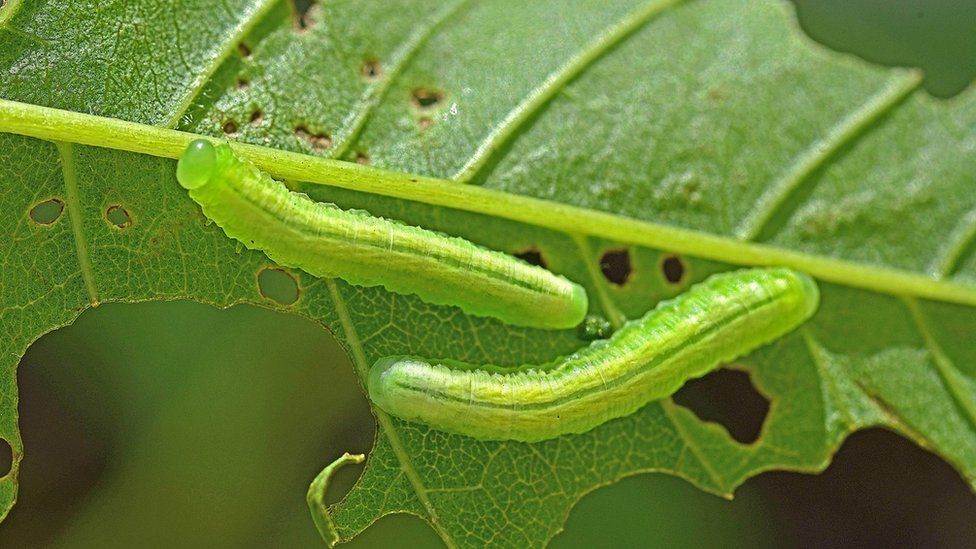Ash sawfly: Invasive insect threatens NI's native trees
- Published

An invasive species of insect is putting ash trees in Northern Ireland under threat, ecologists have warned.
If you have visited areas around the tree-lined towpath which leads from central Belfast to Lisburn recently, you may have noticed some trees are all but bare of their summer leaves.
You may also have noticed hordes of tiny lime-green caterpillars beneath them.
But these caterpillars will not turn into butterflies.
They are the larvae of the ash sawfly, a highly destructive species thought to have arrived in Northern Ireland in 2016.
During the months of May and June, the caterpillars build up in large numbers and can devour every leaf on an ash tree leaving a bare, skeletonised canopy.
They have devastated trees in the area extending from the Belvoir estate in Belfast, where the species was first spotted.
Ash sawfly have since been found in County Fermanagh and as far south as County Meath in the Republic of Ireland.
By the end of June the caterpillars will have disappeared, burying themselves in the soil to pupate, ready to hatch again in April.
But by then the damage done to the foliage of one of Northern Ireland's most common trees will be easy to see.
Joshua Clarke, of invertebrate conservation trust Buglife, said it is now impossible to eradicate ash sawfly.
"Prevention is always going to be the first defence, but we need to learn what is causing these outbreaks," he said.
"Only 8% of Northern Ireland's woodlands are in favourable condition - if a habitat is in unfavourable condition it is more susceptible to invasion from sawfly or any other invasive species."
He said forestry practices, climate change or imported soil could be to blame for the repeated outbreaks.
"What we can do right now is tackle the the sources of these invasions to minimise the impact," he said.
Already struggling
A familiar part of Northern Ireland's natural landscape, ash timber is commonly used in manufacturing, including for making hurls.
It is also home to a wide variety of wildlife.
But before the arrival of the sawfly the trees were already struggling as a result of the ash dieback disease.
How does ash dieback develop?
Just as Dutch elm disease all but eliminated elm trees in Ireland, there are similar fears about what may happen to the ash species.
More than 90% of ash trees in Northern Ireland are now thought to have ash dieback, which spreads through spores from infected trees, landing on leaves and travelling into the trunk.
Dr Archie Murchie is an entomologist with the agri-food and biosciences institute (AFBI), a body of the Department of Agriculture, Environment and Rural Affairs (DAERA) that plays a key role in protecting Northern Ireland's trees and plants.
He said the future of the ash tree in the region may not be sustainable.
"With the long hours of daylight at this time of year the trees are trying to maximise their photosynthesis," Dr Murchie said.
"If they have no leaves they can't do that - it is going to have an impact."
Long-term damage
He told BBC News NI the sawfly was compounding already disastrous effects of ash dieback.
"As you look around you'll notice that not only do the ash trees not have any leaves on them, but some of the branches are dead as well," he said.
"A lot of our trees are already dying and the sawfly really isn't helping."
He said it was difficult to gauge the long-term damage being inflicted on ash trees.
"We're not seeing the trees die within four or five years, but after 10 years it could be a different story," he said.
Dr Roy Anderson, an insect specialist at the Ulster Museum, said 2023 has been a particularly severe year for ash sawfly defoliation.
Dr Anderson said ash sawfly can also be found in Great Britain, but predators which keep the population under control there are not present in Northern Ireland.
"The problem is, as with many invasive species, parasitic predators didn't arrive with it and the sawfly population has lost natural control."
He said a review could be carried out to assess the possibility of introducing a predator like those found elsewhere.
"If we were serious about trying to control ash sawfly we should introduce parasitic larvae here and slow down the damage being done," he said.
While it is not clear how the destructive species arrived in Northern Ireland, Mr Anderson believes it could have been accidentally imported from Europe.
"This is the danger of importing plants and trees," he said.
"We're importing disease hand over fist and we're introducing very negative aspects of global biodiversity."
AFBI said it is monitoring the spread of ash sawfly has asked anyone who has spotted an infestation to log it on the TreeCheck web app.
Related Topics
- Published2 November 2022